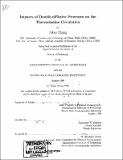Impacts of double-diffusive processes on the thermohaline circulation
Author(s)
Zhang, Jubao
DownloadFull printable version (7.472Mb)
Other Contributors
Woods Hole Oceanographic Institution.
Advisor
Raymond W. Schmitt.
Terms of use
Metadata
Show full item recordAbstract
Double-diffusive processes are studied and parameterized, and their impacts on the oceanic thermohaline circulation are investigated by single-hemisphere numerical models and scaling analysis. Scaling analysis on the thermohaline circulation has been done under three types of surface boundary conditions. (a) Under "relaxation" conditions, there is a two-thirds power law dependence of the meridional overturning rate (and the poleward heat transport) on the diapycnal diffusivity. For any given external forcing, there is only one equilibrium state for the thermohaline circulation. (b) Under "flux" boundary conditions, there is a half power law dependence of the meridional overturning rate on the diapycnal diffusivity. Only one mode is possible for given external forcing. (c) Under "mixed" boundary conditions, multiple equilibria become possible. For given thermal forcing, the existence of multiple equilibria depends on the relative contributions of diapycnal diffusivity and the hydrologic forcing. Numerical experiments are implemented to test the above scaling arguments. Consistent results have been obtained under the above three types of boundary conditions. These provide a basis for understanding how the thermohaline circulation depends on the diapycnal diffusivity, which we know is influenced by the double-diffusive processes of "salt fingering" and "diffusive layering" in some parts of the ocean. In order to examine this issue, the double-diffusive processes are parameterized by diapycnal eddy diffusivities for heat and salt that are different and depend on the local density ratio, ... A background diffusivity is applied to represent turbulent mixing in the stratified environment. The implementation of this double-diffusive - parameterization in numerical models has significant impacts on the thermohaline circulation. (a) Under "relaxation" boundary conditions, the meridional overturning rate and the poleward heat transport are reduced, and water mass properties are also changed. Similar results are obtained under "flux" boundary conditions. (b) Under "mixed" boundary conditions, the critical freshwater flux for the existence of the thermal mode becomes smaller with the double-diffusive parameterization. The extent to which the thermohaline circulation is affected by double-diffusive processes depends on the magnitude of the freshwater forcing.
Description
Thesis (Ph. D.)--Joint Program in Physical Oceanography (Massachusetts Institute of Technology, Dept. of Earth, Atmospheric, and Planetary Sciences; and the Woods Hole Oceanographic Institution), 1998. Includes bibliographical references (leaves 150-157).
Date issued
1998Department
Joint Program in Physical Oceanography; Massachusetts Institute of Technology. Department of Earth, Atmospheric, and Planetary Sciences; Woods Hole Oceanographic InstitutionPublisher
Massachusetts Institute of Technology
Keywords
Joint Program in Physical Oceanography., Earth, Atmospheric, and Planetary Sciences., Woods Hole Oceanographic Institution.